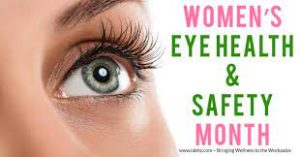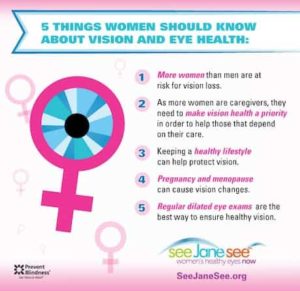Two out of every three people living with blindness or vision problems are women, according to the National Eye Institute. And, data from The Future of Vision: Forecasting the Prevalence and Costs of Vision Problems study shows that women are at higher risk for certain eye diseases and conditions. Prevent Blindness has declared April as Women’s Eye Health and Safety Month in an effort to educate the public on the increased risk for women and vision health issues, as well as steps that can be taken to prevent vision loss.
Women have a higher prevalence of major vision problems, including:
- Age-related Macular Degeneration
- Autoimmune Diseases (such as Lupus or Sjögren’s Syndrome)
- Cataract
- Dry Eye
- Glaucoma
- Low Vision
- Thyroid Eye Disease
- Refractive Error
According to the World Health Organization’s World Report on Vision, women, on average, live longer than men, and are thus at greater risk of developing eye conditions associated with ageing. However, even after controlling for age, global estimates suggest that women with moderate and severe presenting distance vision impairment outnumber men by approximately 7 percent.
Gender and financial disparities can also create barriers to eyecare access for women. A recent study published in JAMA Ophthalmology found that although women were more likely to use eye care, they are also more likely to report difficulty affording eyeglasses than men.
In addition to eye disease and conditions, women have unique health issues related to pregnancy and menopause due to fluctuating hormone levels. Women may notice changes in their ability to see clearly during pregnancy. Women with pre-existing conditions, like glaucoma, high blood pressure or diabetes, need to alert their eye doctor that they are pregnant (or planning to become pregnant). Additionally, dry eye leading to a clinical diagnosis or severe symptoms affects more than 3.2 million American women middle-aged and older.
As ophthalmologists and optometrists re-open their practices temporary closing of the office due to the COVID-19 pandemic, it is important that women make their vision health a priority to help detect vision issues early. Early and consistent treatment for most eye diseases can significantly reduce the risk of vision loss.

